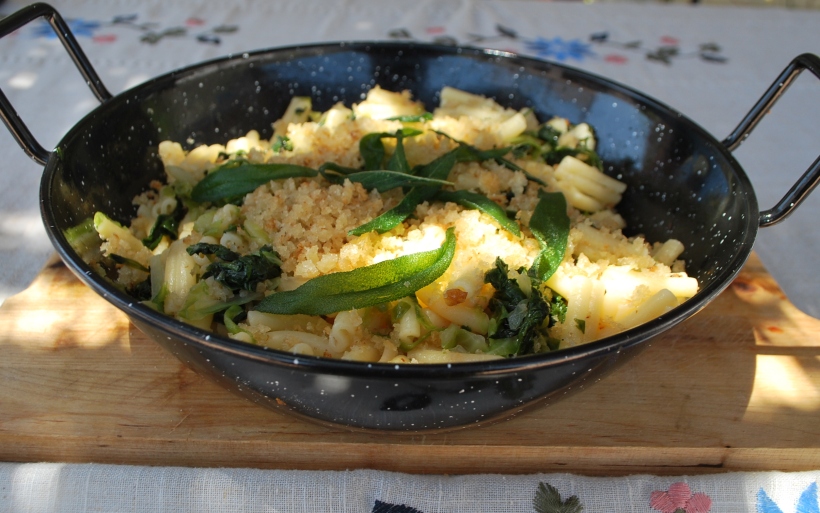Well, anchovy and garlic too, plus a little parmesan at the end but it’s not such a snappy title that way. Big Man came home from one of his little excursions with a beautiful cabbage. I think in England they are called Spring cabbages, the lighter green ones with very tight leaves.

We enjoy it simply shredded and cooked for a few moments until wilted and then served cold with vinaigrette. But this was a whole lot of cabbage and I needed to find other ways to use it. I remembered a lovely Italian pasta dish made with Cavolo Nero (Tuscan Kale) and decided to make something similar.
If you prepare everything before you start cooking it’s quick to pull together, you just need to work methodically and in the time it takes for your pasta to cook (well, dried pasta at least) you’ll have a beautiful meal ready to take to the table.
Ingredients (per person, just multiply per number of diners but don’t worry about being too exact)
- 3 tablespoons of olive oil
- 6 fresh sage leaves
- About 100g finely shredded cabbage
- About 50g fresh white breadcrumbs
- 2 fat cloves of garlic, crushed
- 2-4 tinned anchovies (omit for a vegetarian version)
- Parmesan Cheese
- Your choice of pasta
Start by putting the water for the pasta on to boil and then blanching the shredded cabbage until it wilts. Remove from the water with a slotted spoon and drain, add your pasta to the water and, as long as you have your other ingredients prepared, you can get on with pulling the rest of the dish together.
Heat two thirds of the oil and when it is very hot drop the sage leaves in and cook for about 30 seconds. Remove with a slotted spoon and set aside.

Now add your fresh breadcrumbs and with the oil still on high, move them around in the pan (it helps to use a deep frying pan or wok for this dish) until they start to turn golden. Remove from the pan and put them onto a flat dish to cool slightly and crisp up.
Add the remaining oil to the pan and turn the heat down slightly before adding the garlic and anchovies. When the anchovies have “melted” (this won’t take long at all, a minute or so) add the cabbage and turn the heat back up to high. Stir fry for a couple of minutes (you can allow the edges to brown a little if you like) then add most of the breadcrumbs, reserving some to sprinkle over the top of the dish.
Drain the pasta and mix it in with the cabbage. It helps to add a tablespoon or two of the cooking liquid, but don’t overdo it.
Sprinkle over the remaining breadcrumbs and crispy sage leaves and serve with plenty of parmesan. Buon appetito!
Big Man and I are heading west on Saturday with the pups for a week in Portugal, the Eastern Algarve to be precise. I’ll try to post once more before we head off but it’s turning into one of those weeks. I know we won’t have internet coverage where we’re staying, but fingers crossed that I’ll be able to get online at some point. So…if I go quiet for a while it’s because I’m eating seafood or bacalao and sipping Portuguese wines whilst watching the sea. I’m sure you’ll understand!

























